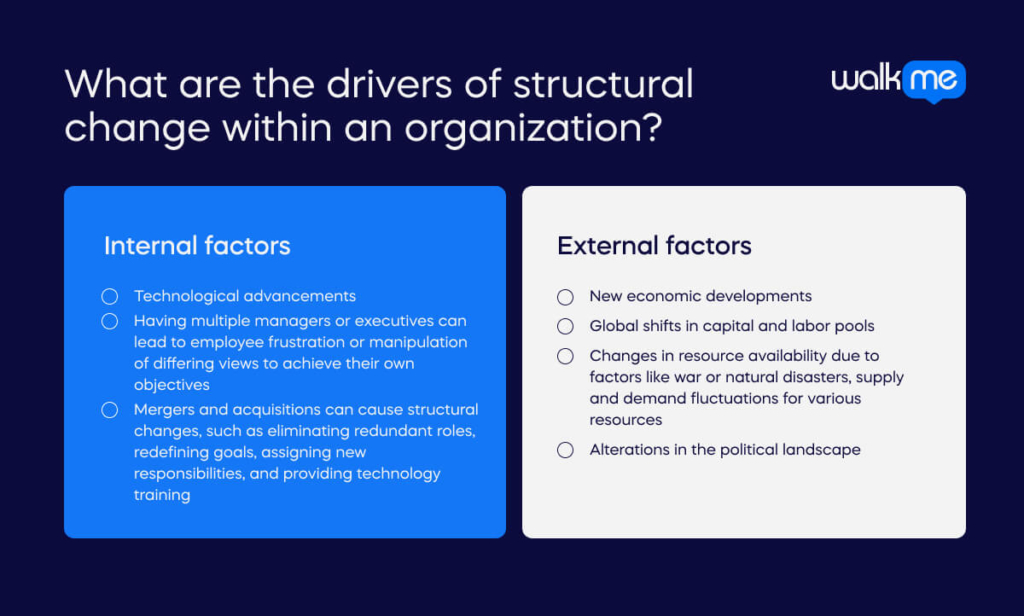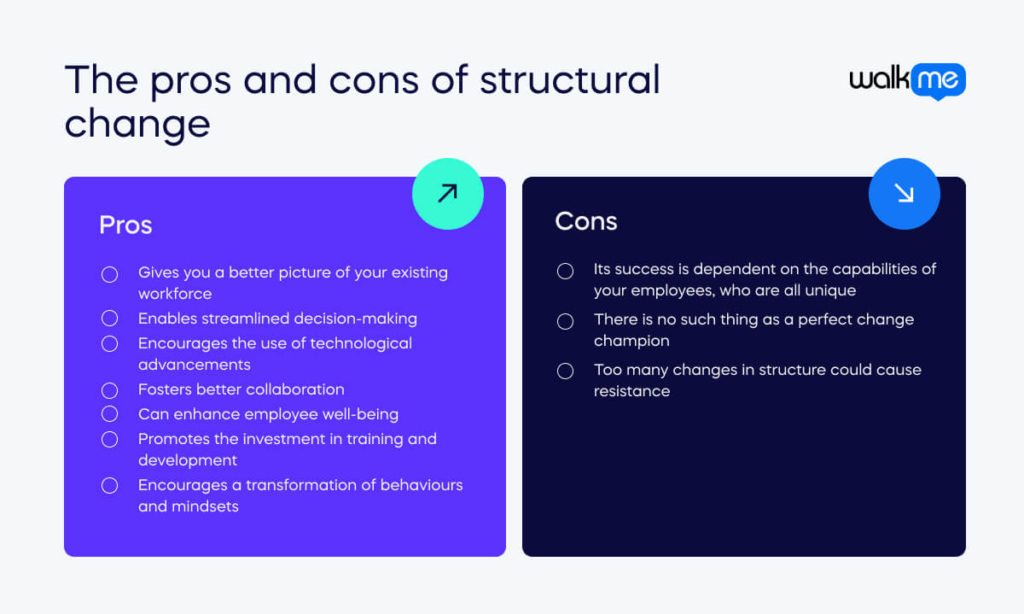Embarking on a new phase in a company’s evolution often necessitates structural change, which entails a deep understanding of the challenges involved to ensure effective management.
When an organization undergoes business transformation or reconfigures its structure, it recognizes that the existing framework has become obsolete and is no longer aligned with current economic realities.
In a business context, structural change encompasses strategic adjustments that profoundly impact the organization’s framework. Whether instigated by deliberate management decisions or compelled by external factors, this overhaul is crucial for adapting to the ever-changing market.
Implementing structural change successfully demands meticulous planning, precise coordination, and a profound awareness of its significance and repercussions within the business landscape.
This article will delve into the definition and purpose of structural change, explore the various drivers behind such changes in organizations, discuss methods for implementation within businesses, provide practical examples of successful real-life situations, and examine the associated benefits and challenges of structural change.
What is structural change?
Structural market change encompasses a broad spectrum of transformations in the functioning of markets or economies.
Various factors, including shifts in production elements like labor and capital, technological advancements, economic progress, the discovery or depletion of natural resources, or alterations in the political landscape, can trigger these changes.
Consequently, structural changes can bring about lasting modifications to economies, businesses, and the industries in which they operate. These changes, in turn, can influence long-term investment returns.
In terms of a company, structural change refers to modifications made to the organization’s framework, including adjustments to its hierarchy, departments, and reporting relationships.
What is the purpose of structural change?
The primary objective of structural change is to improve organizational efficiency, coordination, and responsiveness.
Next, it aims to proactively instill business resilience and enhance the organization’s ability to navigate evolving industry landscapes and market dynamics. It involves mastering the art of organizational reconfiguration, regardless of external shifts or challenges.
One significant benefit of introducing structural change is the creation of new learning opportunities for employees. In many cases, individuals may become disengaged or bored when their roles become stagnant and fail to provide them with avenues for personal and professional growth.
By embracing structural change, organizations can invigorate their workforce with fresh challenges and opportunities for skill development, thus fostering greater job satisfaction and employee retention.
Furthermore, structural change equips companies with the adaptability to thrive in constant change and uncertainty.
It allows organizations to evolve and pivot effectively in response to external disruptions and market fluctuations, positioning them for long-term success in a dynamic business landscape. Structural change is a strategic tool for building organizational resilience and maintaining a competitive edge.
What are the drivers of structural change within an organization?

Organizational structural change can result from both internal and external factors. Recognizing early signs of impending change enables better preparation and the implementation of policies to keep the company on a growth trajectory.
External drivers of change could include new economic developments, global shifts in capital and labor pools, changes in resource availability due to factors like war or natural disasters, supply and demand fluctuations for various resources, or alterations in the political landscape, such as regime changes or significant shifts in business regulations and taxation laws. These drivers impact not only businesses but also markets.
Internal changes in business practices can lead to structural shifts, such as transitioning from department autonomy to centralized operations or creating new departments to meet company needs.
Technological advancements, like online shopping or voice-activated devices, also drive structural changes in service industries by rendering specific skills and vocations obsolete, leading to permanent changes in production and spending.
Moreover, multiple managers or executives within an organization may necessitate change. This can result in employee frustration or manipulation of opposing views by employees to achieve their objectives. In such cases, adjusting the organizational structure to eliminate excess positions and align departments with individual managers is crucial.
Mergers and acquisitions can also trigger structural changes involving eliminating redundant roles, redefining goals, clearly delineating new responsibilities, and technology training as vital components of effective change management during these transitions.
How to implement structural change

To achieve a successful structural change, it is essential to implement multiple phases that ensure a smooth transition.
By following these steps, you can keep your business on the right track throughout the process:
Understand current structural challenges
To embark on a journey of structural change within your organization, you must first understand the current problems or challenges that need to be addressed. This involves thoroughly assessing the existing organizational framework, processes, and practices.
Equally important is identifying the solutions or improvements you intend to implement. These solutions should align with your organization’s strategic goals and long-term vision.
Set clear desired objectives
Once you’ve identified the challenges, setting clear objectives for the structural change is crucial.
Transforming identified weaknesses into well-defined goals is a proactive change management approach. For instance, if your organization struggles with accountability or governance, one of your objectives might be enhancing these structures.
Document your desired metrics and the philosophy behind it
To measure the success of your structural change, it’s essential to document the key metrics and performance improvement indicators used for evaluation.
Additionally, document the philosophy behind these metrics. Explain why they are relevant and how they contribute to the organization’s success.
Plan for the execution of the change
Creating a comprehensive plan is critical to implementing structural changes successfully. This plan should outline the entire change process from start to finish.
It should include strategies for achieving the necessary changes, a timeline, resource allocation, and methods for measuring progress.
This plan may involve activities to support individuals in navigating these changes successfully. It’s essential to recognize that employees cannot be expected to seamlessly adapt to a new structure without proper facilitation.
Engaging in discussions about the transition from the old structure to the desired new one can significantly help move the organization forward.
Facing unexpected team or structural changes can be challenging for employees, whether they are being moved to a new team at work or are forced to seek new employment due to external factors like the ripple effects of events such as COVID-19.
Both scenarios can benefit from seeking guidance from a mentor, manager, or a buddy program to help individuals through the adjustment process.
Evaluate your ideal future structure
Consider what the ideal organizational structure should look like to address the identified challenges and achieve your objectives.
Assess which current employees align with this desired structure and whether any roles need to be filled externally to support the new framework.
Initiate communication about the change with the top first
Once you’ve designed the new structure and developed a plan, initiate communication by announcing the impending change, explaining the reasons behind it, and outlining what will be expected of each individual as part of the change.
Gain leadership buy-in from top-level leaders who will be crucial in implementing and overseeing the new structure. These leaders should align with the change process and provide valuable feedback to refine the plan.
Communicate the change to team leaders or influential change champions
Once top-level leaders are on board, communicate the changes to leaders within specific teams or departments. Ensure that individuals with new managers or changing roles are promptly informed, reducing uncertainty and resistance.
This is also the stage when discussions may take place with individuals who no longer fit within the organization.
Consider actively involving a team of influential employees to identify significant benefits for your workforce. This is particularly important when dealing with diverse organizational cultures.
Since different perceived benefits address other facets of resistance, introduce a combination of perceived benefits and have your employee team champion these benefits and the overall change initiative.
After communicating the change to this group of employees, encourage an employee feedback loop so they feel involved in the decision-making process. This feedback can yield valuable insights for refining your implementation plans.
Broaden communication efforts to the broader organization
Once feedback from your change champions is applied, extend your communication efforts to reach the entire organization. Clearly articulate the goals of the structural change, the data that drove the decision, the specific changes being made, and the metrics used to measure success.
Keep all employees informed throughout the process to maintain transparency and build trust.
Continually empower employees during the implementation
Once implementation begins, empower employees at all levels to excel in their new roles within the restructured organization.
Provide the necessary support and resources to help them navigate the transition and ensure that they can effectively perform their roles.
Monitor progress made
Continuously monitor the progress of the structural change initiative. Regularly reference and update the established employee performance metrics and other measurements to track success.
Highlight quick wins and long-term improvements to demonstrate the positive impact of the changes on the organization’s overall performance and objectives.
Practical examples of structural change
When implementing structural change, you will find it helpful to refer to these examples of organizations successfully putting structural change in place:
Apple
Apple is renowned for its “functional” corporate setup, which does not delineate specific product divisions for iPhone, iPad, or AirPods, which moves away from a siloed structure. Instead, it houses teams responsible for software engineering, hardware development, machine learning, design, and services.
However, a significant shift is underway due to the development of the Apple Vision Pro headset, which will establish its distinct division within the company, internally referred to as the “Vision Products Group” (VPG).
This group operates autonomously from Apple’s primary software and hardware engineering departments. It maintains dedicated teams for these domains, as well as for strategy, computer vision, content, application development, and project management. The rationale behind this structural adjustment is to enhance the headset’s development.
The separation enables a more expeditious and confidential work environment. Given the complexity of the Vision Pro product, Apple experts recognize the necessity of having a specialized team. The corporate structure will persist until the headset attains greater commercial viability.
PepsiCo
At the beginning of 2023, PepsiCo appointed Mustafa Shamseldin as its category growth officer and chief marketing officer (CMO) for the international foods division. This marked a significant shift to bring marketing and operations closer together.
In his dual role as CMO, Shamseldin oversees the company’s brands and plays a pivotal role in shaping its overall business model.
This change has resulted in the consolidation of all the division’s business functions, including Research and Development (R&D), insights, and communication, under a single unified structure instead of operating in isolated silos.
Consequently, his team is now responsible for evaluating new products and concepts, assessing their costs, devising commercialization strategies, planning launches, and monitoring their performance.
The work encompasses brand-related tasks but goes beyond that, focusing on business model innovations and fostering an end-to-end perspective.”
Shamseldin recognized the importance of all teams collaborating toward a shared set of objectives. He believed that the most innovative ideas and work could originate from anywhere. This approach has allowed advertising teams in Mexico to create campaigns with global reach, while the team in India can produce ads aired in the United States.
A new internal name was chosen through a competition among the division’s employees to reinforce a sense of team identity. Shamseldin also encouraged the team to draft a one-page document outlining the division’s purpose and collaborative processes, which the rest of the business now uses as a reference.
The pros and cons of structural change

While implementing structural changes within an organization can be a challenging endeavor, the long-term benefits far outweigh the initial difficulties:
Gives you a better picture of your existing workforce
Structural changes provide valuable insights into your workforce, shedding light on their capabilities, thought processes, and problem-solving abilities.
This deeper understanding enables you to assess your organization’s current standing, identify its strengths and weaknesses, and plan future structural improvements.
Enables streamlined decision-making
One of the primary benefits of structural change is the elimination of unnecessary layers of management. This simplifies decision-making processes and reduces bureaucratic hurdles.
With a flatter organizational structure, critical decisions can be made more swiftly, allowing the organization to adapt to changes in the business environment with agility.
Encourages the use of technological advancements
Structural changes often involve technology adoption. These tools can automate routine tasks, thereby enhancing workflow efficiency.
Whether implementing sophisticated software or artificial intelligence, technology can significantly boost productivity and reduce the manual workload.
Fosters better collaboration
Restructuring encourages cross-functional collaboration within the organization. Different departments and teams can collaborate more closely, sharing insights and expertise.
This collaborative culture often leads to the generation of innovative solutions and improved problem-solving capabilities, which are crucial for staying competitive.
Can enhance employee well-being
Structural changes may introduce flexible work arrangements, such as remote work policies, in response to evolving workforce needs. This shift can improve the employee experience by offering greater work-life balance options without the stigma traditionally associated with remote work. Happy and balanced employees are more productive and engaged.
Promotes the investment in training and development
Structural changes often necessitate investing in employee training and development programs. This investment results in the expansion of knowledge, the acquisition of invaluable skills, and the development of new behaviors. Well-trained employees are better equipped to navigate the changing landscape of a learning organization.
Encourages a transformation of behaviours and mindsets
Beyond structural modifications, organizations can leverage these changes to transform behaviors, mindsets, and other relevant mechanisms. This transformation can significantly enhance the organization’s competitive edge. It promotes adaptability, innovation, and a forward-thinking culture.
Alternatively, the challenges of structural change are:
Its success is dependent on the capabilities of your employees, who are all unique
Successful structural change within an organization is contingent upon the readiness and capabilities of its employees to adapt to new roles and responsibilities. However, equipping employees for these transitions goes beyond typical training methods like classroom sessions or on-the-job training.
In many cases, the complexities and nuances of structural change necessitate a more comprehensive approach to ensure a smooth transition. For instance, when structural change is adaptive and allows for gradual implementation, organizations can create a ‘test environment.’
This environment provides employees with a safe space to familiarize themselves with new systems, processes, and responsibilities. It offers them time to ramp up their skills and confidence, reducing the risk of performance gaps during the transition.
Conversely, if structural change is more reactive and immediate, comprehensive standard operating procedure (SOP) documentation becomes paramount.
Detailed SOPs should cover all aspects of change, from new systems and processes to revised job roles and responsibilities. This documentation serves as a crucial reference point for employees navigating the changes. However, creating such detailed guides for employees might not be possible if this type of change is new.
There is no such thing as a perfect change champion
When selecting a change management agent or champion to influence frontline workers to adopt a change, there can be differing perspectives between leadership and employees.
While leadership may perceive a team leader as an ideal candidate for this role, employees may hold a contrary view. They could have a bad relationship with this person, making them resist any future change.
Conduct thorough stakeholder analyses encompassing all organizational levels to address this potential issue proactively. This involves identifying key individuals and groups impacted by the proposed change. Consider their existing relationships, attitudes, and potential concerns regarding the change.
Create an organizational change risk profile that outlines potential risks and challenges associated with specific stakeholders. This profile should highlight any pre-existing conflicts, resistance tendencies, or communication barriers that may hinder the change process.
Once potential risks are identified, develop clear and actionable mitigation strategies. These strategies should be tailored to address the unique dynamics of each stakeholder group. For instance, if there are concerns about resistance due to strained relationships with a team leader, consider alternative change champions or communication methods.
Too many changes in structure could cause resistance
It’s important to note that frequent and continual structural change cycles can harm an organization. Widespread layoffs, role confusion, inconsistent processes, and a lack of clear direction can decrease employee loyalty, morale, and overall organizational performance.
Therefore, organizations should avoid unnecessary structural changes and focus on stability and employee well-being.
Final steps on structural change
Structural change within organizations can stem from various triggers, such as acquisitions, growth periods, leadership shifts, or the recognition of ineffective management practices. When organizations implement structural changes, they thoroughly analyze their existing models, hierarchies, and operational processes to pinpoint areas requiring enhancement.
It’s important to note that structural change can manifest in adaptive, reactive, or anticipatory forms. In the context of anticipatory change, companies proactively reorient themselves, preparing to embrace a new structure that can effectively navigate and withstand the dynamic forces of the market, social shifts, political landscapes, and environmental pressures.
Companies that exhibit agility and swiftly adapt to these evolving circumstances often emerge most successful in such scenarios.
However, it’s crucial to acknowledge that responses to these changes, whether recent developments or unfamiliar processes, can vary significantly from one individual to another within the organization. Therefore, it becomes essential for organizations to strategize their approach before initiating structural changes.
Before embarking on the change management journey, consider outlining a well-structured plan that delineates the steps required to achieve the desired end goal. This plan should encompass data-driven decision-making, feedback collection mechanisms, and eliminating redundant phases that do not contribute to the overarching objectives.
In essence, a comprehensive structural change plan should begin by clearly articulating the nature of the impending changes and how they might impact specific areas of the organization.
This approach helps address concerns and uncertainties among team members and stakeholders. Moreover, it empowers individuals to comprehend the rationale behind the change, fostering a shared understanding of the goals and their respective roles in facilitating its successful implementation.

Frequently Asked Questions
Digital transformation often requires organizations to adopt flatter hierarchies, enhance cross-functional collaboration, and implement agile decision-making processes, leading to significant structural changes.
Aligning structure with strategy ensures that organizational design supports strategic objectives, facilitating effective execution and adaptability in dynamic markets.
Organizations should reassess their structures during significant events such as mergers, market shifts, or technological advancements to maintain efficiency and competitiveness.
Addressing employee resistance involves transparent communication, involving staff in the change process, and providing training to ease transitions and foster acceptance.

